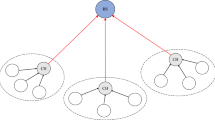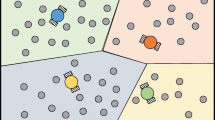Abstract
In harsh outdoor terrains like disaster areas and urban toxic, regions optimal placements of static sensor nodes might not be possible, leading to possible incomplete coverage of the region. In such situations, mobile sensor nodes (MSNs) might be a better option and a significantly fewer number of nodes are required than their static counterparts. A triangulation-based coverage where, groups of three MSNs position themselves to form equilateral triangles, has several applications in localization, 3D imaging and coordinated search operation. In this paper, we present several mobile traversal algorithms (MTA) based on triangulation coverage that employs N ≥ 3 MSNs such that, up to N − 3 node failures can be tolerated. MTA achieves three objectives: (a) as N increases, the total time to cover the field decreases in the absence of a failure; (b) each MSN travels a minimum distance; (c) upon a failure, the remaining MSNs efficiently complete the coverage of the field. The bounds on the total traveling distance and time are derived and the tightness of the bounds are proven through simulations. Furthermore, we also derive the bounds on the distance traveled by an MSN to complete the coverage process. The bounds on the individual traveling distances are useful in minimizing and bounding the energy consumption of the MSNs.


















Similar content being viewed by others
Notes
Which refers to the establishment of the location knowledge in ground objects like ground sensors with the aid of the beacon signals from the three MSNs.
References
Bai X, et al. (2006) Deploying wireless sensors to achieve both coverage and connectivity. In: ACM MOBIHOC, Florence, 22–25 May 2006
Cardei M, Thai M, Li Y, Wu W (2005) Energy-efficient target coverage in wireless sensor networks. In: IEEE INFOCOM. Miami, 13–17 March 2005
Carle J, Simplot D (2004) Energy efficient area monitoring by sensor networks. IEEE Comput 37(2):40–46
Itai A, Papadimitriou CH, Szwarcfiter JL (1982) Hamiltonian paths in grid graphs. SIAM J Comput 11(4):676–686 (November)
Khan A, Qiao C, Sharma P, Tripathi SK (2007) An energy-efficient mobile triangulation-based coverage scheme. In: IEEE international conference on communications (ICC). IEEE, Piscataway, pp 3527–3534, June
Tian D, Georgannas N (2002) A coverage-preserving node scheduling scheme for large wireless sensor networks. In: ACM workshop on WSNA. Atlanta, 28 September 2002
Ye F, Zhong G, Lu S, Zhang L (2003) Peas: a robust energy conservation protocol for long-lived sensor networks. In: Int’l conf. on distributed computing systems (ICDCS). Baltimore, 19–23 May 2003
Author information
Authors and Affiliations
Corresponding author
Additional information
Preliminary versions of the paper analyzing cases where N = 3 and N ≥ 4 have appeared in ICC‘07 and Qshine‘07 respectively.
Rights and permissions
About this article
Cite this article
Khan, A., Qiao, C. & Tripathi, S.K. Mobile Traversal Schemes based on Triangulation Coverage. Mobile Netw Appl 12, 422–437 (2007). https://doi.org/10.1007/s11036-008-0044-6
Received:
Accepted:
Published:
Issue Date:
DOI: https://doi.org/10.1007/s11036-008-0044-6




